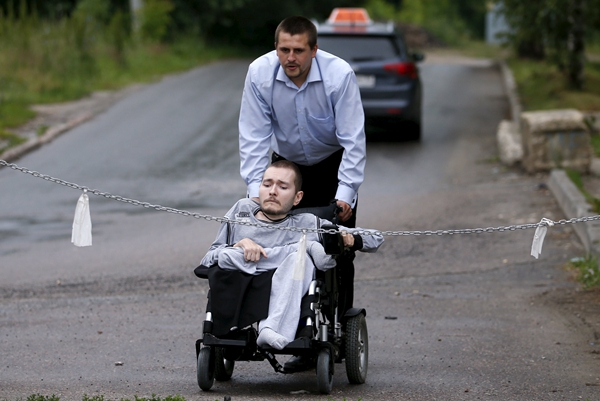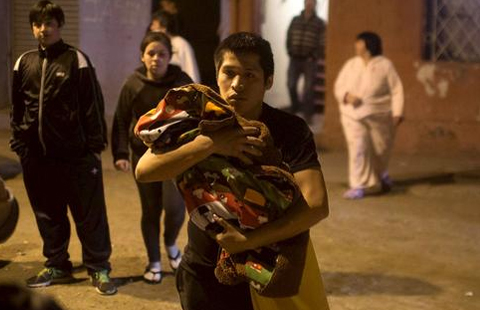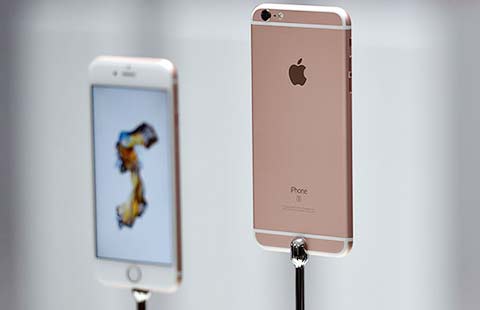First human head transplant may be carried out in 2017 in China
Updated: 2015-09-15 16:25
By Wu Yan(chinadaily.com.cn)
|
||||||||
 |
|
Valery Spiridonov is assisted before a news conference in Vladimir, Russia, June 25, 2015.[Photo/Agencies] |
What is a head transplant?
A head transplant is taking a living head and putting it onto a new body.
But actually, it’s a body transplant, as the head will be gaining a new body to control. However, as the term “whole body transplant” is already used to mean transferring the brain between bodies, calling it a “head transplant” makes it clear that the whole head is to be switched, brain included.
How would Canavero’s human head transplant work?
The donor body and the head to be attached are first cooled down to 12-15˚C to ensure that the cells last longer than a few minutes without oxygen. The tissue around the neck is then cut, with the major blood vessels linked with tiny tubes. The spinal cord on each party is then severed cleanly with an extremely sharp blade.
At this point, the head is ready to be moved, and the two ends of the spinal cord are fused using a chemical called polyethylene glycol, encouraging the cells to mesh.
After the muscles and blood supply are successfully connected, the patient is kept in a coma for a month to limit movement of the newly fused neck, while electrodes stimulate the spinal cord to strengthen its new connections.
Following the coma, Canavero anticipates that the patient would immediately be able to move, feel their face and even speak with the same voice. He believes physiotherapy would allow the patient to walk within a year.
What does the scientific community make of the human head transplant?
Dr Hunt Batjer has attracted headlines for being particularly blunt: “I would not wish this on anyone. I would not allow anyone to do it to me as there are a lot of things worse than death.”
Dr Jerry Silver witnessed the 1970s monkey head transplant experiment and describes the procedure as “bad science”, adding that “just to do the experiments is unethical”.
Dr Chad Gordon, professor of plastic and reconstructive surgery and neurological surgery at Johns Hopkins University, agrees that Canavero’s claims are scientifically implausible.
Dr Paul Myers, associate professor of biology at the University of Minnesota at Morris, puts it even more explicitly: “This procedure will not work... Try it with monkeys first. But he can’t: the result would be, at best, a shambling horror, an animal driven mad with pain and terror, crippled and whimpering, and a poor advertisement for his experiment. And most likely what he’d have is a collection of corpses that suffered briefly before expiring.”
Others wonder whether Canavero might simply be enjoying the limelight with a PR stunt, including Dr Arthur Caplan, director of ethics at the NYU Langone Medical Centre. Describing the doctor as “nuts,” he explained to CNN: “Their bodies would end up being overwhelmed with different pathways and chemistry than they’re used to, and they’d go crazy.”
- Chinese surgeon uses 3D printing to map out difficult heart surgery
- China completes first kidney re-transplant operation
- Overhauling China's organ transplant system could take some time
- Mother with womb transplant says risk paid off
- Lung transplant operation on man, 81, may be world record
- 3D print tech involved in Beijing axis surgery
- UN chief: Those blocking fleeing refugees should 'stand in their shoes'
- Hungarian riot police detain migrants
- IOC announces five cities bid for 2024 summer Olympic
- Japan opposition to halt vote on security bills
- Japan protesters rally as security bills near passage
- Australia launches first air strikes against IS

 Messy dorm earns grueling punishinment for students
Messy dorm earns grueling punishinment for students
 Seven killed as rainstorm triggers landslide in SW China
Seven killed as rainstorm triggers landslide in SW China
 Chinese armed forces arrive in Malaysia for joint military exercise
Chinese armed forces arrive in Malaysia for joint military exercise
 Top 10 M&A deals between China and US in 2015
Top 10 M&A deals between China and US in 2015
 Delicious bites in record-breaking sizes
Delicious bites in record-breaking sizes
 Popular Chinese dishes in the US
Popular Chinese dishes in the US
 Evacuation ordered after M8.3 earthquake hits Chile’s coast
Evacuation ordered after M8.3 earthquake hits Chile’s coast
 Donate sperm to get an iPhone 6s
Donate sperm to get an iPhone 6s
Most Viewed
Editor's Picks

|

|

|

|

|

|
Today's Top News
Economy worries prompt Fed to hold rates steady
Google demos online marketing strategies to support Chinese SMEs
The ancient city takes a new route along the Silk Road
Villagers angry at verdict on fatal fire
Promoting the landscapes of China
Uber's Chinese rival backs US rival Lyft
Positive tone struck for Xi's US visit
Xi to press case for Bilateral Investment Treaty
US Weekly

|

|







